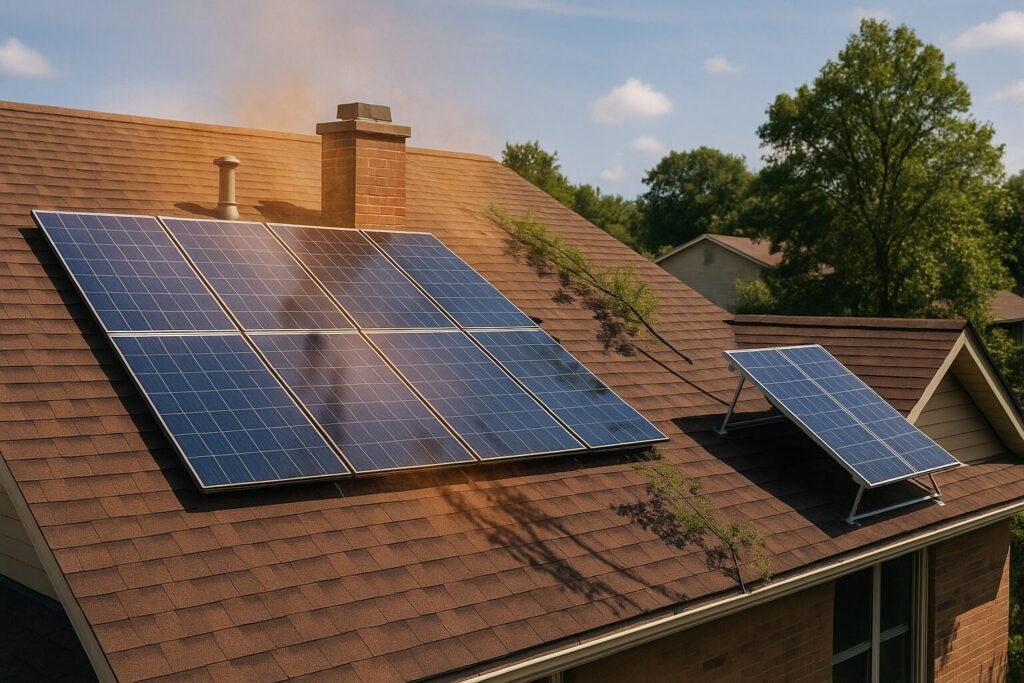Solar Panel Efficiency: Real-World Factors & Easy Wins
Boost solar panel efficiency: cut heat, shade, and soiling, optimize tilt and MPPT, and use NOCT to set realistic output. Practical tips for real roofs.
TL;DR Snapshot (for Skimmers)
- Heat, shade, and tilt/orientation are the biggest day-to-day efficiency killers.
- Real-world output ≠ datasheet. Use NOCT and your performance ratio to set expectations.
- Easy wins: improve convective cooling, reduce partial shading, clean on a smart cadence, and tune MPPT/inverter settings.
- New to PV? Start with the basics: How Solar Panels Work: Simple Guide to Sun-Powered Energy.
The Day My “Perfect” Array Underperformed
I expected blue skies to deliver record watts. Instead, a warm June afternoon brought a dip right when the sun was brightest. A pencil-thin vent-pipe shadow slid across one module, and a layer of spring dust dulled the glass. That day taught me a simple truth: solar panel efficiency isn’t just about sunlight; it’s about managing losses—thermal derating, partial shading, and soiling.
If you’re just getting oriented, skim this primer first: The Basics of Solar Energy: From Sunlight to Electricity. Then come back here for practical fixes.
Skim-Stopper Box: Quick Actions to Boost Efficiency
- Temperature: Check your panel’s temperature coefficient and improve airflow under modules.
- Shade: Run a 9/12/3 shade walk and use MLPE where needed (more in Solar Panel System Components Explained (Easy Guide).
- Tilt & Orientation: Aim for true south (N. hemisphere) and tilt ≈ latitude; details in Optimal Angle for Solar Panels: Quick, Proven Tips
- Soiling: Clean when production is ~5–10% below baseline.
- Expectations: Learn why STC vs. NOCT matters in real-world ratings.
1) Heat & the Temperature Coefficient: Why Hot Panels Make Less Power
My “best” summer day wasn’t best at all. At 2 p.m., output fell below 11 a.m.—on a cloudless day. The culprit was heat. PV cells are semiconductors; as cell temperature rises, voltage drops, so you see thermal derating.
What to know
- The temperature coefficient (Pmax) (often −0.3% to −0.5%/°C) tells you how quickly power falls as modules heat.
- NOCT estimates realistic outdoor cell temps. A hot, dark roof and tight standoffs raise backsheet temperature and depress performance ratio.
5-minute heat check
- Open your panel datasheet; note the Pmax temp coefficient.
- Estimate cell temp: ambient + 20–30 °C in full sun.
- Multiply °C rise by the coefficient to estimate power loss.
- If losses are big, increase standoff/air gap or consider a ground mount.
2) Shade & Obstructions: The Tiny Shadow That Breaks a String
I watched a narrow chimney shadow clip a single cell. The whole series string sagged. Bypass diodes helped, but module mismatch still hurts.
What to know
- In series strings, even partial shading can bottleneck current and cause mismatch losses.
- Common offenders: vent stacks, chimneys, dormers, antennas, and branches.
- MLPE—microinverters or DC optimizers—can salvage energy on shade-prone roofs. Learn how these fit into your system in Solar Panel System Components Explained (Easy Guide).
9/12/3 Shade Walk
- Check the array area at 9 a.m., 12 p.m., 3 p.m.
- Map moving shadow edges and note seasonal changes.
- Mark offenders and consider module relocation, careful trimming, or adding MLPE.
If shade is unavoidable, see Grid-Tied vs Off-Grid Solar: Which System Fits You? for setups that pair better with partial shade.
3) Orientation & Tilt: Set It (Mostly) and Forget It
My first roof forced an east–west layout. I expected disappointment, but discovered a benefit: gentler peaks and better morning/evening coverage for my loads.
What to know
- Orientation: True south (N. hemisphere) or true north (S. hemisphere) maximizes annual plane-of-array irradiance.
- Tilt: About latitude for all-year balance; flatter in summer, steeper in winter, if you can adjust.
- East/west still performs well, shifting energy toward morning and evening.
Get angles and examples here: Orientation & Tilt Optimization. If you’re still planning the layout, pair it with the Placement Guide.
4) Weather: Clouds, Haze, Humidity, Snow, and Wind
My “worst” cloudy day surprised me. Peaks were lower, but diffuse irradiance kept production steady. Sometimes the cloud-edge effect even gave quick boosts.
What to know
- Clouds: Lower irradiance, but not zero—diffuse light still makes power.
- Haze/humidity: Scatters sunlight and trims insolation a bit.
- Snow: Coverage blocks light; surrounding snow raises albedo, boosting output on clear days.
- Wind: A free convective cooling fan that improves module efficiency.
Curious how weather interacts with storage during low-sun hours? Check Do Solar Panels Work at Night? Cloudy-Day Truths
5) Soiling: Dirt, Dust, Pollen, and Bird Droppings
Spring pollen humbled me. A gentle rinse brought production back and restored long-term energy yield.
What to know
- Soiling losses vary by climate, tilt, and rain frequency.
- Clean when output is ~5–10% below your clean baseline or after big dust/pollen events.
- Lower tilts collect more grime; hydrophobic coatings and a decent self-cleaning tilt help.
Safe cleaning basics
See the step-by-step with gear and safety notes: Clean Solar Panels to Boost Solar Efficiency.
6) Panel Tech: Mono vs. Poly, PERC, TOPCon, HJT, Thin-Film
Upgrading a test array from older poly to modern mono PERC improved low-light starts and midday stability on my roof.
What to know
- Mono PERC, TOPCon, HJT: Generally higher module efficiency with better passivation/structures; temperature coefficients vary by model.
- Thin-film: Lower efficiency per area but often gentler temperature behavior—useful on hot, large surfaces with space.
7) Degradation & Warranties: Reading the Fine Print
I graphed annual output and saw a gentle slope—just what the performance warranty predicted.
What to know
- Typical module degradation: ~0.25–0.6%/year depending on make/model.
- After 25 years, many modules guarantee output retention around ~84–92%.
- Two warranties: product (materials/workmanship) and performance (minimum output curve). Full walkthrough: How Long Do Solar Panels Last?.
8) Balance-of-System Losses: MPPT, Inverters, Wiring, Connectors
A friend’s array “underperformed” until we checked the inverter loading ratio—too much DC on too small an inverter, causing clipping at noon.
Where watts disappear
- Inverter efficiency: Look at realistic CEC/Euro ratings.
- MPPT efficiency: Good tracking helps under changing light/temperature.
- Wiring: Excess voltage drop steals power—size conductors right.
- Connectors/terminations: Resistance adds up; keep them clean and tight (per code).

9) Mounting & Ventilation: Give Panels Room to Breathe
I moved a test string from a dark, hot roof to an elevated ground rack. Same sun, cooler backsheet, better module efficiency.
What to know
- Ground mounts or well-ventilated racks usually run cooler than tight flush roofs.
- Maintain the recommended air gap to promote convective airflow.
- Dark roofs and low standoffs trap heat and increase thermal derating.
10) Bifacial & Albedo: When the Back Side Helps
A carport with light gravel below outperformed a similar flush roof. The rear-side irradiance created a noticeable bifacial gain.
What to know
- Best with elevated, open-back mounts and reflective ground (white membranes, light gravel, snow with high albedo).
- On tight flush roofs, the back side often sees too little light to matter.
11) STC vs. NOCT (or PTC): Why Datasheet Watts Don’t Match Your Roof
My early forecasts were too rosy because I assumed STC. Real roofs live closer to NOCT.
What to know
- STC: 1000 W/m² and 25 °C cell temperature—great for comparing models, not for forecasting.
- NOCT/PTC: Closer to real outdoor conditions; add derating factors (temp, soiling, BOS) to estimate your performance ratio.
- Want to estimate production? Use a calculator like NREL PVWatts.
Quick external resource: NREL PVWatts Calculator (estimate annual kWh with your tilt, azimuth, and location).
Field Test: A One-Hour DIY Site Audit
- Shade walk (9/12/3): Map moving shadows; photograph offenders.
- Tilt/azimuth check: Confirm orientation
- Ventilation scan: Measure standoff; look for blocked airflow.
- Soiling check: Compare today’s output to your clean baseline; schedule cleaning if ~5–10% down.
- Inverter logs: Look for clipping and MPPT oddities.
- Expectations: Re-forecast with NOCT and climate data.
Practical Conclusions & Takeaways
- Focus on the controllables: shade, heat, airflow, cleanliness, and BOS tuning.
- Track production and compare against NOCT-based expectations to monitor your performance ratio.
- Make one change at a time so you know what actually helped your long-term energy yield.
FAQs (Quick Hits)
Do clouds kill production?
No. Diffuse irradiance still generates power—sometimes with quick cloud-edge boosts. See Cloudy Days & Nighttime Guide.
How often should I clean panels?
When output is ~5–10% below the clean baseline or after heavy pollen/dust. Step-by-step in the Cleaning Guide.
Is east/west worth it?
Often yes. You’ll shift energy to mornings/evenings—great for home loads. Read Orientation & Tilt.
